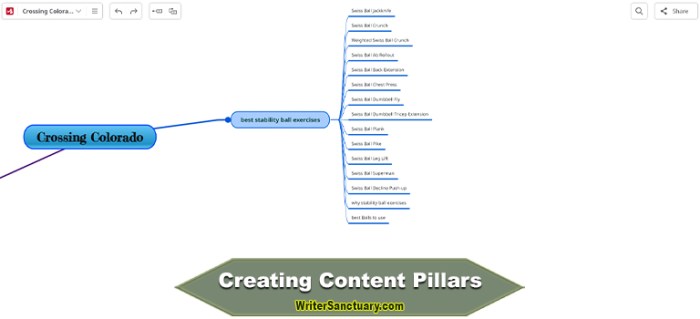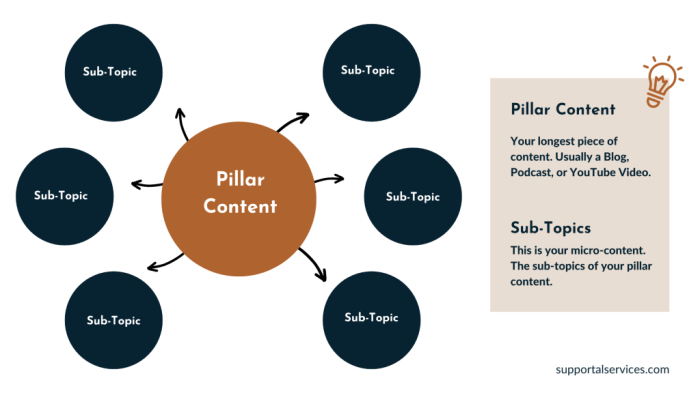Creating Content Pillars sets the stage for a strategic approach to content creation, guiding you through the process of establishing key topics that define your brand’s narrative. Get ready to dive into the world of content strategy with a fresh perspective and actionable insights.
What are Content Pillars?
Content pillars are the main topics or themes that form the foundation of a brand’s content strategy. They represent the core areas of focus that align with the brand’s values, goals, and target audience.
Creating content pillars is essential for a successful content strategy as they help in organizing and structuring content creation efforts. By establishing these main pillars, brands can maintain consistency, relevance, and coherence across their content, making it easier to connect with their audience and build brand authority.
Importance of Content Pillars, Creating Content Pillars
Content pillars play a crucial role in guiding content creation and distribution. They serve as a roadmap for developing a variety of content pieces that are aligned with the brand’s messaging and objectives.
- Content pillars help in establishing brand identity and positioning by focusing on key themes that resonate with the target audience.
- They enable brands to create a cohesive content strategy that covers different aspects of their products or services, ensuring a holistic approach to engaging with customers.
- Content pillars also aid in and content optimization efforts by providing a framework for creating relevant and valuable content that attracts and retains audience interest.
Examples of Businesses Benefiting from Content Pillars
- 1. E-commerce: A clothing brand can have content pillars around fashion trends, styling tips, and sustainable fashion to engage with their audience and showcase their products.
- 2. Technology: A software company may focus its content pillars on industry insights, product features, and customer success stories to educate and inform their audience about their solutions.
- 3. Food and Beverage: A restaurant chain could center its content pillars on recipes, food culture, and behind-the-scenes stories to connect with food enthusiasts and showcase its menu offerings.
Identifying Pillar Topics
When it comes to identifying pillar topics for your brand or niche, it’s important to focus on core subjects that are not only relevant to your business but also resonate with your target audience. This means diving deep into what makes your brand unique and what your audience is interested in.
Researching Trending Topics
To ensure your content pillars stay fresh and engaging, it’s crucial to research trending topics within your industry. This can be done by monitoring social media trends, utilizing Google Trends, and staying updated with industry news and publications. By incorporating trending topics into your content pillars, you can attract a wider audience and stay relevant in a fast-paced digital world.
Aligning with Business Goals and Audience Interests
Aligning pillar topics with your business goals and target audience interests is key to driving success. Consider what your business aims to achieve and how your content can support those objectives. Additionally, analyze your audience demographics, preferences, and behaviors to ensure your pillar topics are tailored to their interests. By striking a balance between business goals and audience interests, you can create content pillars that are both impactful and engaging.
Developing Pillar Content: Creating Content Pillars

Creating high-quality pillar content is essential for establishing authority and driving traffic to your website. To do this effectively, you need to focus on providing valuable information that is both informative and engaging. Here are some strategies and tips for creating top-notch pillar content.
Strategies for High-Quality Pillar Content
- Research extensively to understand your target audience’s needs and preferences.
- Create content that is comprehensive, well-organized, and easy to read.
- Use a mix of text, visuals, and multimedia to enhance the user experience.
- Incorporate relevant s naturally to improve .
Structuring Pillar Content for and User Engagement
When structuring your pillar content, consider the following tips:
- Start with a compelling introduction to grab the reader’s attention.
- Organize your content using headers, subheadings, and bullet points for easy readability.
- Include internal and external links to provide additional resources and improve .
- Optimize your content for mobile devices to reach a wider audience.
Importance of Multimedia Elements in Pillar Content
Adding multimedia elements like images, videos, and infographics can greatly enhance your pillar content:
- Visuals help break up text and make the content more visually appealing.
- Videos can engage users and convey information in a more dynamic way.
- Infographics are great for summarizing complex information and making it easier to understand.
- Including multimedia elements also improves the overall user experience and can increase time spent on your website.
Pillar Content Distribution
When it comes to distributing pillar content, you’ve got to hit up all the hot spots, fam. From social media to email newsletters, you gotta spread the word like it’s fire. Let’s break it down and get those pillars shining bright.
Different Channels for Distributing Pillar Content
- Blast it on Social Media: Hit up Instagram, Twitter, Facebook – wherever your audience hangs out. Share those pillars like they’re the hottest gossip in school.
- Email Newsletters: Slide into your peeps’ inboxes with all the deets on your pillar content. Make ‘em wanna click and read more.
- Guest Blogging: Get your pillars featured on other blogs to reach new homies who might dig your content.
Strategies for Promoting Pillar Content
- Engage with Your Audience: Respond to comments, DMs, and engage in conversations to keep the buzz going.
- Collaborate with Influencers: Team up with cool cats in your niche to give your pillar content some extra street cred.
- Run Contests and Giveaways: Get the hype going by offering prizes or exclusive content to those who engage with your pillars.
Repurposing Pillar Content for Different Formats and Channels
- Create Snackable Content: Chop up your pillar content into bite-sized pieces for social media posts or stories.
- Turn it into Videos: Take your pillars to the next level by creating video content for YouTube or TikTok.
- Transform into Podcast Episodes: Share your pillar content in audio format for peeps who love to listen on the go.
Measuring Pillar Content Success

When it comes to evaluating the success of your content pillars, key performance indicators (KPIs) play a crucial role. These metrics help you understand how well your content is performing and where there is room for improvement.
Key Performance Indicators for Pillar Content Success
- Organic Traffic: The number of visitors coming to your website through search engines without paid promotion.
- Engagement Metrics: Metrics like time on page, bounce rate, and social shares can indicate how well your content is resonating with your audience.
- Conversion Rate: Tracking how many visitors take the desired action after consuming your pillar content, such as signing up for a newsletter or making a purchase.
- Backlinks: The number and quality of websites linking back to your pillar content can boost your and credibility.
Tools and Methods for Tracking Pillar Content Performance
There are various tools available to help you track the performance of your pillar content. Google Analytics is a popular choice for measuring website traffic and user behavior. Social media analytics tools like Hootsuite or Buffer can provide insights into engagement metrics. Additionally, tools like SEMrush or Moz can help monitor backlinks and rankings.
Importance of Analyzing Metrics for Future Strategies
Analyzing metrics from your pillar content is essential for optimizing future content strategies. By understanding what is working and what isn’t, you can make data-driven decisions to improve your content quality, distribution channels, and overall impact on your target audience.
